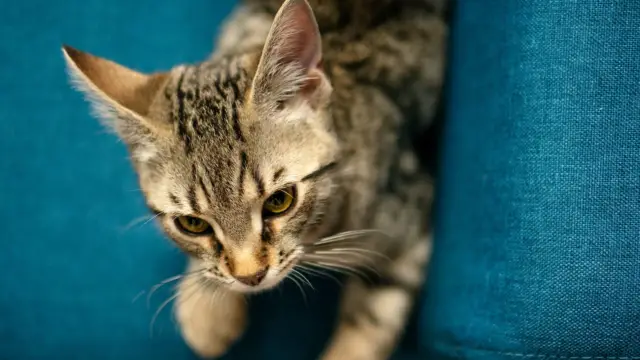
Cats are known for their graceful movements, mysterious behaviors, and unique characteristics. One such characteristic that often captures our attention is the way they move their ears. It’s fascinating to observe how their ears can swivel, rotate, and twitch in different directions. But have you ever wondered why cats move their ears? In this article, we will explore the science behind this intriguing behavior and unravel the secrets of a cat’s ears.
Anatomy of a cat’s ear
To understand why cats move their ears, it’s important to know the anatomy of their ears. A cat’s ear is a complex structure that consists of three parts: the outer ear, the middle ear, and the inner ear. The outer ear, also known as the pinna, is the visible part that we see. It is highly mobile and can move independently, thanks to nearly 30 muscles. These muscles allow the cat to rotate, raise, and lower its ears, enabling it to pinpoint sounds with remarkable precision.
The role of ear movements in cat communication
Ear movements play a crucial role in cat communication. Cats are highly vocal animals, but they also rely on body language to convey their messages. By moving their ears, cats can express a wide range of emotions and intentions. For example, when a cat’s ears are erect and facing forward, it indicates that the cat is alert and interested in something. On the other hand, if the ears are flattened against the head, it signals fear or aggression. By paying attention to their ear movements, we can better understand our feline companions and respond accordingly.
How cats use their ears to express emotions
Cats are masters at hiding their emotions, but their ears can give us valuable insights into their state of mind. When a cat is content and relaxed, its ears are usually in a neutral position, facing forward. This shows that the cat is comfortable and at ease. Conversely, if the ears are pulled back or flattened against the head, it indicates that the cat is feeling threatened or scared. Understanding these subtle ear movements can help us create a safe and soothing environment for our cats, ensuring their well-being and happiness.
The connection between ear movements and hunting instincts
Cats are natural hunters, and their ear movements are closely tied to their hunting instincts. When a cat spots prey or detects a sound, its ears will immediately swivel and rotate towards the source. This allows the cat to precisely locate the target and plan its attack. The remarkable flexibility of a cat’s ears enables them to capture even the faintest sounds, making them highly efficient predators. So, the next time you see your cat’s ears twitching, remember that it’s a reflection of their innate hunting prowess.
Common reasons why cats move their ears
There are several common reasons why cats move their ears. One of the primary reasons is to locate the source of a sound. Cats have an incredible ability to detect high-frequency sounds, which is essential for their survival. By moving their ears, they can accurately determine the direction and distance of the sound, helping them assess potential threats or prey. Additionally, cats may move their ears to express their mood or emotions, as mentioned earlier. They may also adjust their ear position to regulate their body temperature, as the ears are particularly sensitive to heat and cold.
The science behind a cat’s ability to detect sounds through ear movements
A cat’s ability to detect sounds through ear movements is truly remarkable. It all begins with the unique structure of their ears. The shape of a cat’s ears, with their pointed tips and large surface area, acts as a natural amplifier. This allows them to capture even the faintest of sounds and enhances their auditory sensitivity. Furthermore, the muscles in a cat’s ears allow for precise directionality. By independently moving their ears, cats can triangulate the position of a sound, helping them accurately locate its source. This remarkable auditory system is a testament to the evolution and adaptation of cats as skilled hunters.
Interesting facts about cat ears and their unique abilities
Did you know that cats have a wider range of hearing than humans? While humans can hear sounds within the frequency range of 20 Hz to 20,000 Hz, cats can detect sounds between 48 Hz and 85,000 Hz. This heightened hearing ability is due to the structure of their ears and allows them to perceive ultrasonic sounds that are beyond human capacity. Additionally, cats have a unique ability to move their ears independently, enabling them to monitor different sounds simultaneously. This gives them an advantage in detecting potential threats or prey in their environment.
Tips for understanding and interpreting your cat’s ear movements
Now that we understand the science behind why cats move their ears, let’s explore some tips for understanding and interpreting their ear movements. First and foremost, observe your cat’s ears in different situations. Take note of the position, direction, and movement of their ears when they are relaxed, alert, or agitated. This will help you build a baseline understanding of your cat’s ear language. Additionally, pay attention to other body language cues, such as tail position and facial expressions, to get a complete picture of your cat’s emotions. Finally, remember that each cat is unique, and their ear movements may vary slightly. By developing a close bond with your feline friend, you will become more attuned to their individual communication style.
Appreciating the fascinating science behind cats’ ear movements
In conclusion, the science behind why cats move their ears is truly fascinating. From the intricate anatomy of their ears to the way they use ear movements to communicate and hunt, cats have evolved remarkable auditory abilities. By understanding and interpreting their ear movements, we can deepen our connection with our feline companions and provide them with the care and environment they need. So, the next time you see your cat’s ears twitching or rotating, take a moment to appreciate the incredible science behind this captivating behavior.
If you found this article interesting and want to learn more about cat behavior, check out our comprehensive guide on feline body language and communication. Understanding your cat’s behavior can help strengthen your bond and provide them with a happy and fulfilling life.
If you enjoyed my article, I would appreciate you sharing it with your network.

Sima Ndlebe
Sima writes for CatBuzz. He is interested in Cats, Health and Fitness, and Entrepreneurship.
Published: 30 October 2023



